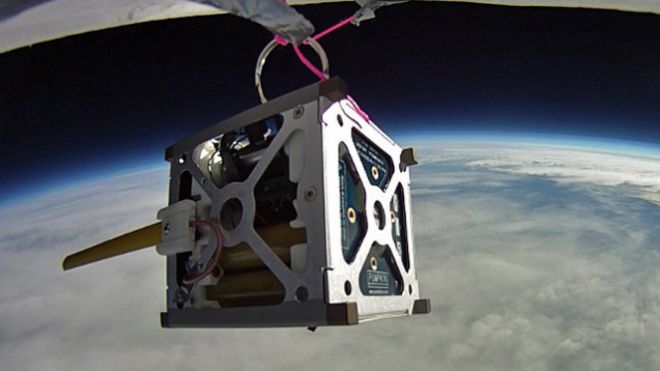
When Orbital Sciences’ Antares rocket roared into orbit Sunday, most eyes were focused on the performance of the new vehicle on its maiden voyage or on the deployment of an inert mass simulator for the Cygnus cargo ship. However, one set of payloads aboard the “A-ONE” mission received relatively little attention. They were quietly ejected from the second stage of Antares at 5:09 p.m. EDT, right on the edge of space, and nine minutes after the booster rocketed away from Pad 0A at the Mid-Atlantic Regional Spaceport (MARS) on Wallops Island, Va.
Meet the PhoneSats.
Four tiny “picosatellites” were deployed from a small dispenser. One of them, known as Dove-1, is dedicated to amateur radio, but the others may prove to be the lowest-cost satellites ever flown into space. The PhoneSats—named Alexander, Graham, and Bell, in honor of the Scottish-born inventor of the world’s first practical telephone—are designed to determine if a consumer-grade smartphone can be used as the main flight avionics system for a capable, yet inexpensive, satellite. Since their launch Sunday, transmissions from all three PhoneSats have been received at multiple ground stations on Earth, indicating that they are functioning normally. They should remain in orbit for up to two weeks.
“Out-of-the-box smartphones already offer a wealth of capabilities needed for satellite systems,” noted NASA’s Space Technology Mission Directorate, “including fast processors, versatile operating systems, multiple miniature sensors, high-resolution cameras, GPS receivers, and several radios.” Although NASA added other components, the cost of the PhoneSats was capped at $3,500 and the design and objectives were kept to a minimum for this first flight. To prepare for the A-ONE mission, the PhoneSat hardware was tested in various extreme environments, including thermal vacuum chambers, vibration and shock tables, suborbital rocket flights, and high-altitude balloons.

“It’s always great to see a space technology mission make it to orbit,” said Michael Gazarik, NASA’s associate administrator for space technology in Washington, D.C. “The high frontier is the ultimate testing ground for new and innovative space technologies of the future. Smartphones offer a wealth of potential capabilities for flying small, low-cost, powerful satellites for atmospheric or Earth science, communications, or other space-borne applications. They also may open space to a whole new generation of commercial, academic, and citizen-space users.”
In addition to sending information about their health back to Earth, the PhoneSats will also attempt to take photographs of the Home Planet with their cameras. A “watchdog circuit” is monitoring their systems and can reboot the phones if they stop transmitting radio signals. The specific hardware is the Google-HTC Nexus One smartphone, running the Android operating system, to which NASA added a larger, external lithium-ion battery and a more powerful radio for messages transmitted from space.
The smartphone’s ability to send and receive calls and text messages has been disabled and is mounted in a “1U” CubeSat, with a capacity of 1 liter. Each CubeSat measures about 4-inches-square and weighs 2.4 pounds. Potential future applications for PhoneSat technology include advanced heliophysics—which NASA’s upcoming Edison Demonstration of Small Satellite Networks mission seeks to trial—as well as qualifying new technologies and components for spaceflight and conducting low-cost observations of Earth.
Want to keep up-to-date with all things space? Be sure to “Like” AmericaSpace on Facebook and follow us on Twitter:@AmericaSpace



